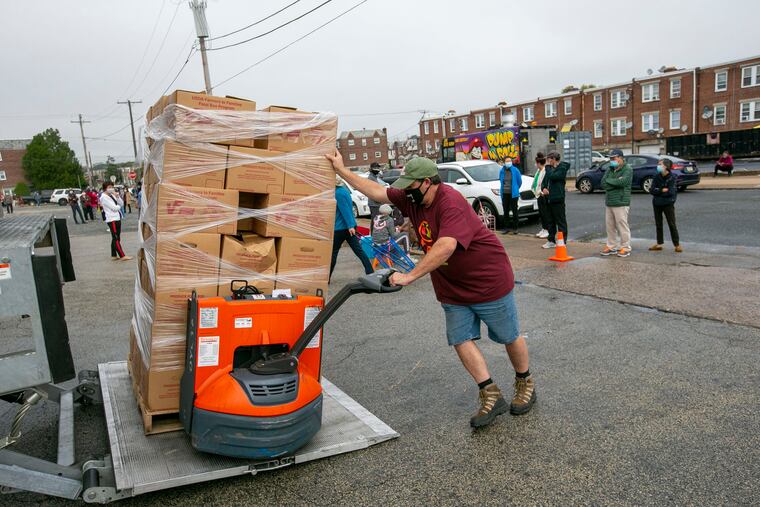Many poor families were better off during the pandemic. It shouldn’t be that way.
In 2022 and 2023, we received an 88% increase in requests for food from local families. Why, when we saw what could work in 2020, are we backsliding into more inequity?

According to the U.S. government and the World Health Organization, COVID-19 is no longer a public health emergency.
Symbolically, this is welcome news for those wanting to put this ugly chapter behind us. But so many of the crises that were exacerbated by the pandemic are far from over — and may even be worse.
During the pandemic, the U.S. government provided some relief to the ongoing crush of poverty in the form of tax credits, emergency rental assistance, supplemental unemployment benefits, enhanced nutritional benefits (food stamps, or SNAP), and farm-to-family food boxes. Now that the public health emergency has ended, so have all those benefits.
In their place, organizations like ours — the Share Food Program — have had to scramble to fill in the gaps.
» READ MORE: ‘Catastrophe’ at Philly food bank short on funding and food because of administrative change
In his recent book, Poverty, by America, sociologist Matthew Desmond demonstrates that during the early pandemic, despite one of the hardest economic free falls of the last century, the United States actually lifted 16 million people out of poverty, because of government intervention. Around that same time, child poverty was cut by half.
Then, throughout 2021 and 2022, an odd thing happened. Health outcomes improved, but poverty began to rise again, after a string of baffling decisions to reduce economic aid to only the nation’s most vulnerable. Poverty started climbing as elected officials in Washington ended many of the core programs that lifted so many Americans out of poverty’s grip for the first time.
Here at Share Food Program, despite serving more people than we ever have per month during the peak of the pandemic, we started to see our federal funding and supplies of food cut by more than 60% (or completely axed, like the aforementioned farm-to-families program). Even the city of Philadelphia cut our funding in half.
Yet, between January 2022 and February 2023, we experienced an 88% increase in requests for food from local families — which means more people turning to our partner pantries, more people signing up for emergency food relief, and more seniors in need of home delivery.
That’s an almost 90% increase in need — in just over one year.
This declaration that the national emergency is over without making real and systemic change is a movie we’ve all seen before.
In 2008, with banks collapsing and the stock market in a free fall, elected officials scrambled to stop the bleeding. Many of these large corporations and banks saw an immediate cash infusion, and the government provided some short-term relief for lower-income families. Yet, true systemic change never happened. When will the people get a bailout?
In 2007, one in eight Americans lived below the poverty level. In 2023, nearly 40 million people still do. We haven’t even begun to tackle our true national emergency of poverty and inequity.
Nothing makes me prouder than serving hundreds of thousands of folks, including the 300,000 kids we estimate we reach across nearly 800 schools through our partnership with the National School Lunch Program. But with that pride also comes a sense of sadness.
Why, in the founding city of the richest nation in the history of the world, is so much of our region’s food system relying on our food bank? Why, when we saw what could work in 2020, are we backsliding into more inequity? Why are we forcing vulnerable seniors to choose between medicine and meals? Why are we again forcing parents to choose between rent and feeding their kids? Why are we casually deflating life rafts when countless hardworking Americans are still facing an economic riptide?
Reinstating child tax credits, emergency rental assistance, supplemental unemployment benefits, enhanced SNAP allocations, and farm-to-family food boxes isn’t going to eradicate poverty tomorrow. But what we did see in the early days of the pandemic is that these public policies and programs made a substantial impact.
We need to recognize we’re still in a national emergency. The consequences of widespread, unchecked hunger come with a cost far steeper than investing in proven social safety nets.
We need to recognize we’re still in a national emergency.
We need all hands on deck in this fight for food justice. Engage with community organizers and elected officials. Urge members of Congress to reinstate critical supports that have been gutted. Volunteer at your local food bank. Donate food or money to hunger relief organizations directly serving those in need today.
We’ve seen firsthand that we don’t have to let people go hungry. We don’t have to keep watching the same movie on a loop; let’s change the ending.
George Matysik is the executive director of the Share Food Program in Hunting Park.